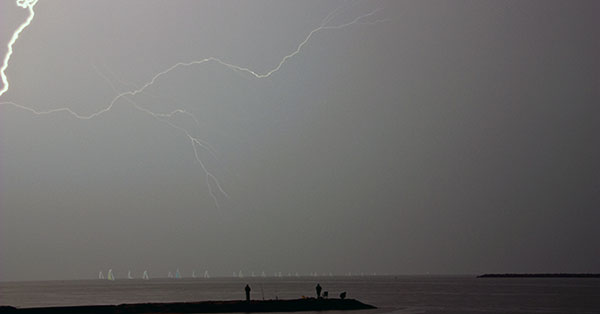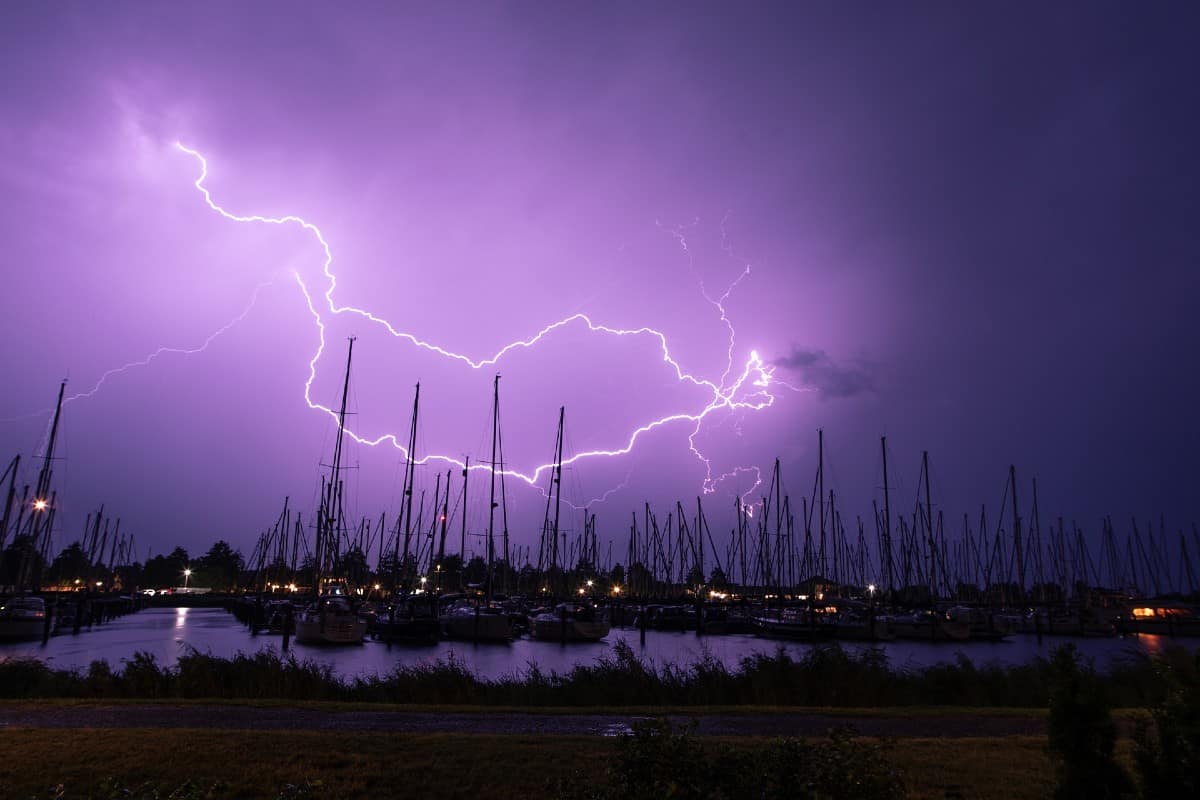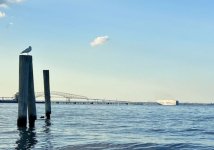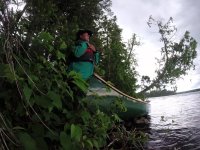-
Happy Premiere of Tchaikovsky's "The Nutcracker" (1892)! 🩰🥥🧚
You are using an out of date browser. It may not display this or other websites correctly.
You should upgrade or use an alternative browser.
You should upgrade or use an alternative browser.
Paddling in a lightning storm
- Thread starter Glenn MacGrady
- Start date
As others do, I usually head for the shore and find shelter among shoreline trees - but not the highest trees around. Sometimes I will get out on shore and take shelter. One question that has been in my head for years: What to do if you are camped on a fairly small island with a limited number of trees?
I have heard about squatting on your pack (or now, PFD) but have not had to try that. I'm not sure I could do that for very long.
Although other factors should probably not enter the equation, for me they often do. How far away do I think the storm is? How close to the campsite, take-out, etc.? If anyone in the group is particularly frightened by lightning? There are probably other factors that I might consider. In some of these cases, whether wise or not, I might tend to keep going. In other cases I might chose to stop. For me it's often situational. The odds are long but the consequences are huge.
In an interesting but related topic, a group was camped along a short portage in northern Saskatchewan when a severe storm hit them. The wind was very, very strong and many trees were falling. One of the leaders took the group to the upwind side of the portage and they waited out the storm there on the edge of a storm lashed lake. At first glance, I thought that was the wrong side to take shelter on because you would be exposed to the full strength of the wind. It seemed better to me to take shelter at a place where the forest would offer some protection from the wind. His explanation was that being on the "sheltered" downwind side meant that the group would be in line falling trees. He felt it was better to deal with the wind rather than risk having someone hit by one of the many falling trees.
I have heard about squatting on your pack (or now, PFD) but have not had to try that. I'm not sure I could do that for very long.
Although other factors should probably not enter the equation, for me they often do. How far away do I think the storm is? How close to the campsite, take-out, etc.? If anyone in the group is particularly frightened by lightning? There are probably other factors that I might consider. In some of these cases, whether wise or not, I might tend to keep going. In other cases I might chose to stop. For me it's often situational. The odds are long but the consequences are huge.
In an interesting but related topic, a group was camped along a short portage in northern Saskatchewan when a severe storm hit them. The wind was very, very strong and many trees were falling. One of the leaders took the group to the upwind side of the portage and they waited out the storm there on the edge of a storm lashed lake. At first glance, I thought that was the wrong side to take shelter on because you would be exposed to the full strength of the wind. It seemed better to me to take shelter at a place where the forest would offer some protection from the wind. His explanation was that being on the "sheltered" downwind side meant that the group would be in line falling trees. He felt it was better to deal with the wind rather than risk having someone hit by one of the many falling trees.
Years ago I played golf with a guy who used a 2 iron. He could wack the crap out of that ball with that thing where I would slice the crap out of it. We used to say "Only God and Todd can hit a 2 iron" .You know the advice given to golfers caught out on the course in an electrical storm? Quickly grab a 2-iron and hold it aloft as it is well known that not even God can hit a 2-iron.
Lighting is a funny beast and is my second greatest fear in the back country after rabid raccoons. Mostly the fear centers around my tent melting across my body from a lighting strike. I know that is not reasonable or rationale but fear usually isn't reasonable or rational. Other then while laying in my tent I basically just try to stay out of the wide open spaces. I will hang along shore or on shore during a storm and if on small river I will paddle on. I have endured a lot of storms while traveling outside and staying in tents and figure that as long as I am not in the middle of a lake or top of a mountain I don't worry about it.
Boat US also sells boat insurance and tracks a lot of data. One piece of data I found interesting is that the height of mast compared to other boats in marina does not change your chances of being struck. I have always been surprised at the difference between catamarans and monohull sailboats chances of being struck by lighting. 6.9 vs 3.8 chances out of a 1000. Pontoon boats are .1 chances out of 1000. So i will take my chances in a canoe. It is really quite amazing how few sailboats get struck by lighting.

How Likely Is Your Boat To Be Struck By Lightning
According to reports from our BoatUS Marine Insurance claim files, the odds of your boat being struck by lightning in any year are about one in 1,000.
One time in Guatemala my wife and I hiked up to the top of a volcano with a small tour group of about 10 people including local guides. I was a little apprehensive because lighting was striking nearby peaks and higher up towards the summit. As we exited the vegetated areas and entered the moonscape type lava fields and marveled at the lava and landscape mingling around a quarter mile or so from trees and maybe half mile to summit. Lighting is still hitting numerous peaks around us. Then one of the other folks says something about someones hair standing up because of static electricity. With in less then 15 seconds everyone's hair is standing straight up off our heads. I am immediately say we need to get below tree line now! The guides were like no problem es beuno etc. I said fine by me we will meet you at the tree line. My wife and I high tailed it to the trees and the rest of the group began to follow while the guides said not to worry etc attempting to get us to stay in open and hang out. We all live to tell the tale.
One of the things that I remember about that is the herd mentality. There was a short conversation some were wanting to stay because guides were cool with it and I said something along the lines. I am not an expert but the training and experience I have had is to not go above tree line in lighting storm and if your hair is standing on end odds are good a strike is imminent. Stay if you want but we will meet you at the tree line. If we had not been there all would have gladly stayed. I am usually the guy to say your fine don't worry about it what are the odds but that day to my calculation the odds were not in our favor.
With in less then 15 seconds everyone's hair is standing straight up off our heads.
Definitely a high risk situation with high electrical potentials being built up between the charged ions in your body and the oppositely charged ions in the lightning cloud. A strike is likely imminent. You were very smart to get to a safer place pronto.
https://www.weather.gov/mqt/lightningtips : "If your hair stands on end, lightning is about to strike you. Drop to your knees and bend forward but don't lie flat on the ground. Wet ground is a good conductor of electricity."
Bingo. Lots of low-probability/high consequence threats while outdoors.The odds are long but the consequences are huge.
Lightning is definitely up there on the high consequence side, and the probability of being struck increases fast when you do something like stand above treeline on an exposed ridge during a storm. Canoeing/lightning strike probability is trickier I think, and FoxyOtter's boat insurance stats would support that. We were racing a thunderstorm back to camp on Henderson Lake on my last outing. Looking at all the ADK high peaks around us, we wondered how being surrounded by high peaks, but still being the tallest thing in the middle of the lake, would affect the odds of being hit by lightning. We decided it was better to continue the academic debate from the safety of camp rather than out on the lake.
Looking at @Foxyotter's insurance statistics, I would fathom the explanation is as simple as catamarans being more likely (or having operators more likely) to be out in higher winds and more inclement weather than monohulls, as a whole. And pontoon boats are generally fair weather only boats.
It likely has nothing to do with mast height or hull construction. And once harboured, they're typically near a lightning rod of some sort. Most marinas have one.
Slightly off topic, but if you've never seen the CN Tower get struck by lightning... WOWSA! It's quite a sight.
It likely has nothing to do with mast height or hull construction. And once harboured, they're typically near a lightning rod of some sort. Most marinas have one.
Slightly off topic, but if you've never seen the CN Tower get struck by lightning... WOWSA! It's quite a sight.
PacketFlend I think there would be many a old salty captains that would disagree with you. There are more monohull sailboats sailing the worlds oceans then catamarans. I do not know but my guess was that catamarans build up more static charge with the two hulls.
In regards to the lighting rod they are designed to dissipate a direct strike to a structure. They do not attract a strike they just allow it the shortest path to ground. I doubt a lighting rod on a marina building would offer any protection to a boat 100 meters away. Many sailboats are grounded to either a steel or lead keel or a copper plate outside of haul. It is more common on salt water but often undersized. Lighting is more likely to cause damage in fresh water and requires significantly larger surface area to dissipate strike. The fresh water vs salt water difference is due to the solution of ions that carry electricity to ground with sea water being significantly higher. Which also illustrate the danger of Electric Shock Drowning (ESD). The risk of ESD is much higher in fresh water then salt water. ESD can be a problem around any marina or dock with electricity. If there is a short in the ground all electrical will still work while electricity uses a prop or some conductor to ground in the water. The danger zone for fresh water is much wider then salt water. The human body is more conductive then the fresh water too.
In regards to the lighting rod they are designed to dissipate a direct strike to a structure. They do not attract a strike they just allow it the shortest path to ground. I doubt a lighting rod on a marina building would offer any protection to a boat 100 meters away. Many sailboats are grounded to either a steel or lead keel or a copper plate outside of haul. It is more common on salt water but often undersized. Lighting is more likely to cause damage in fresh water and requires significantly larger surface area to dissipate strike. The fresh water vs salt water difference is due to the solution of ions that carry electricity to ground with sea water being significantly higher. Which also illustrate the danger of Electric Shock Drowning (ESD). The risk of ESD is much higher in fresh water then salt water. ESD can be a problem around any marina or dock with electricity. If there is a short in the ground all electrical will still work while electricity uses a prop or some conductor to ground in the water. The danger zone for fresh water is much wider then salt water. The human body is more conductive then the fresh water too.
Well I've spent a lot of time on the water but only in small boats, and never in saltwater (Ontario boy here), so my experience is quite limited.
Still though, on an aggregate scale, these statistics include a great number of amateur captains (myself among them), and I still think my observation, that the inclinations of the operator are a much greater measure of risk than either hull construction or mast height, are valid. The only way a lighting rod "attracts" a strike is by being the most convenient object and shortest path to ground. On that we agree, I think.
To be fair, I haven't read the link. Does it account for crew experience?
Still though, on an aggregate scale, these statistics include a great number of amateur captains (myself among them), and I still think my observation, that the inclinations of the operator are a much greater measure of risk than either hull construction or mast height, are valid. The only way a lighting rod "attracts" a strike is by being the most convenient object and shortest path to ground. On that we agree, I think.
To be fair, I haven't read the link. Does it account for crew experience?
After 30 years tripping in southcentral Ak, where thunderstorms are rare, I forgot how scary they can be. A couple times I planned to ride out a T storm in a baker tent in the yard in Pa. Every time it started to get intense I retreated to the house. I think it was more "good judgement" than fear that sent me inside. As much as I wanted to experience the storm, if something happened, like a lightning strike or falling tree branch people would wonder why I didn't go inside and I'd feel stupid.
In the few times I have been caught out on the water in a deluge, with or without lightning, I head to shore, wedge an end of my boat in a tree and take shelter underneath it. I don't know how much protection from lightning it gives, but it does get you out of the rain.
In the few times I have been caught out on the water in a deluge, with or without lightning, I head to shore, wedge an end of my boat in a tree and take shelter underneath it. I don't know how much protection from lightning it gives, but it does get you out of the rain.
PacketFlend I think I understand what your saying. Are you mostly thinking about small catamarans and monohulls like for racing etc? The article is covering larger 25-60 foot range of sailboats. I could not for the life of me understand why you would think of catamarans going out in worse condition then monohulls until I remember my beach cat hanging in my barn in need of repair. For sure the smaller catamarans like to play in the wind and waves. Though I don't think any of the day sailor types are really in the list.
Two people died yesterday from a lightning strike near the White House.
Do I recall someone here saying they used to try to sneak paddle in the Washington, D.C. reflecting pool?
Do I recall someone here saying they used to try to sneak paddle in the Washington, D.C. reflecting pool?
Yes, but they weren't canoeing. But they were next to trees and a metal fence.Two people died yesterday from a lightning strike near the White House.
Do I recall someone here saying they used to try to sneak paddle in the Washington, D.C. reflecting pool?
A third person has now died from the lightning strike in Lafayette Park across from the White House. A meteorologist said that six separate strikes of lightning hit the exact same spot within a fraction of a second.
As for lightning deaths in the U.S., the National Weather Service says: "According to the NWS Storm Data, over the last 30 years (1989-2018) the U.S. has averaged 43 reported lightning fatalities per year. Only about 10% of people who are struck by lightning are killed, leaving 90% with various degrees of disability. More recently, in the last 10 years (2009-2018), the U.S. has averaged 27 lightning fatalities."
Tracked down the the culprit, @Chip, with lightning speed using our site's Enhanced Search feature:
As for lightning deaths in the U.S., the National Weather Service says: "According to the NWS Storm Data, over the last 30 years (1989-2018) the U.S. has averaged 43 reported lightning fatalities per year. Only about 10% of people who are struck by lightning are killed, leaving 90% with various degrees of disability. More recently, in the last 10 years (2009-2018), the U.S. has averaged 27 lightning fatalities."
Do I recall someone here saying they used to try to sneak paddle in the Washington, D.C. reflecting pool?
Tracked down the the culprit, @Chip, with lightning speed using our site's Enhanced Search feature:
Reminds me of the time I smuggled a canoe onto to Jefferson Memorial’s
Tidal Basin. Across a fence and lowering the canoe down a 5’ retaining wall to the water. It was after hours and felt bandit, even though there is a concession that rents paddle wheelers there during the day. After reading the article I realize I should have carried the boat over to the Lincoln Reflecting Pool, too. Things were more lax 30 years ago. Not sure I’d try that now.
While focused on large boats, the following article about lightning strikes on boats is quite informative, with statistics from insurance sources and technical details about protecting boats with Faraday cages. I'll pull three quotes.
"According to the insurance provider BoatUS, the statistics are very unexpected. Around one in 1000 boats get hit by lightning every year. If there are about 12 million registered boats in America. Knowing that allows the numbers to become a little more clear. That’s 12,000 boats every year getting hit by lightning. One in 1,000 odds are not very high at all."
"If your boat is fifteen feet or less then you can rest a little easier. Statistically speaking, it’s not likely to be hit by lightning at all. It’s not impossible, but the numbers are not even charted, really. You have a 0 in 1,000 chance. That could mean you still have a 1 in 10,000 chance, so don’t think you’re fully immune."
"At 16 feet to 25 feet your numbers increase. There’s a 0.2 in 1,000 chance of any boat at those sizes being struck."

 www.boatsafe.com
www.boatsafe.com
"According to the insurance provider BoatUS, the statistics are very unexpected. Around one in 1000 boats get hit by lightning every year. If there are about 12 million registered boats in America. Knowing that allows the numbers to become a little more clear. That’s 12,000 boats every year getting hit by lightning. One in 1,000 odds are not very high at all."
"If your boat is fifteen feet or less then you can rest a little easier. Statistically speaking, it’s not likely to be hit by lightning at all. It’s not impossible, but the numbers are not even charted, really. You have a 0 in 1,000 chance. That could mean you still have a 1 in 10,000 chance, so don’t think you’re fully immune."
"At 16 feet to 25 feet your numbers increase. There’s a 0.2 in 1,000 chance of any boat at those sizes being struck."

How to Protect Your Boat From Lightning | Boat Safe | Water Sports, Product Reviews, and Nautical News
Of all the dangers you can face at sea, lightning is one that almost no boater considers. Lightning is not a threat in the eyes of most people. It’s considered rare and unusual. You need to get that thought out of your head as a boat owner. Lightning strikes are…
I still haven't had time to read the articles.
But I think the old adage stands: When thunder roars, go indoors.
Not quite the same thing in the wilderness, but the general principle remains the same, I think.
But I think the old adage stands: When thunder roars, go indoors.
Not quite the same thing in the wilderness, but the general principle remains the same, I think.
Nothing like lightning to spark conversation among paddlers. But, ya, go indoors. The only safe place in lightning is within a solid structure.
I never understood the urgency of paddling mates to get off the water in lightning. Emotionally, I understand it. The few times I got stuck on the water during lightning were really scary, and I badly wanted to be somewhere else. But logically, where were they going that was safer? Huddled along the shore under trees. I didn't think that was safer. One group rushed back to our launch point and gathered around a picnic table that was sheltered by a canvas awning suspended from a galvanized pipe structure, under a huge tree. Not safer. Scary as it is, out on the water you are a very small target on a really big background.
An article from the San Diego kayak club provided one reason it's better to be on land. The dangerous shock area on land is smaller than on water. It seems like a direct hit would fry you, but many are injured by electricity that is radiated around the strike. That shock area is smaller on land.
When paddling, look around at all the things that are in the water. These include trees, duck blinds, navigation markers, pilings, fish pens, and so on. These things stay out on the water in every thunderstorm, and they are still there. Except, of course, the ones that did get hit and we don't see anymore. So, ya, low risk, high consequence. I second PacketFlrend. When thunder roars, go indoors!

When all else fails, try the "Lieutenant Dan" method: shake your fist at the sky and yell "is that all you got!"
I never understood the urgency of paddling mates to get off the water in lightning. Emotionally, I understand it. The few times I got stuck on the water during lightning were really scary, and I badly wanted to be somewhere else. But logically, where were they going that was safer? Huddled along the shore under trees. I didn't think that was safer. One group rushed back to our launch point and gathered around a picnic table that was sheltered by a canvas awning suspended from a galvanized pipe structure, under a huge tree. Not safer. Scary as it is, out on the water you are a very small target on a really big background.
An article from the San Diego kayak club provided one reason it's better to be on land. The dangerous shock area on land is smaller than on water. It seems like a direct hit would fry you, but many are injured by electricity that is radiated around the strike. That shock area is smaller on land.
When paddling, look around at all the things that are in the water. These include trees, duck blinds, navigation markers, pilings, fish pens, and so on. These things stay out on the water in every thunderstorm, and they are still there. Except, of course, the ones that did get hit and we don't see anymore. So, ya, low risk, high consequence. I second PacketFlrend. When thunder roars, go indoors!

When all else fails, try the "Lieutenant Dan" method: shake your fist at the sky and yell "is that all you got!"
Solid structures are not always safe. A classmate of mine was killed by seeking shelter with a friend on a kayak trip. When the thunderstorm approached they went ashore and into a fort.. I think it was Fort Foster in Kittery Maine.. They were leaning on concrete but its old concrete with rebar exposed in places.
They were both electrocuted. He died and stayed dead. She was revived by CPR and advanced life support It amazes me that she still continued paddling in later years.
They were both electrocuted. He died and stayed dead. She was revived by CPR and advanced life support It amazes me that she still continued paddling in later years.
The dangerous shock area on land is smaller than on water. It seems like a direct hit would fry you, but many are injured by electricity that is radiated around the strike. That shock area is smaller on land.
There seems to be contradictory information on how far the danger zone is for conductive land travel vs. conductive water travel from a distant lightning strike. THIS article, which I linked and quoted above, says: "On the ground, electrical current spreads out in streams, and this allows it to go farther than if it dissipated uniformly through the water. The uniform dissipation of the electrical charge means that the total affected area is larger than on land, but the distance at which the charge remains dangerous is significantly smaller."
It seems generally agreed in literature I've read that salt water conducts electricity much better than fresh water because the sodium and chlorine atoms in the salt molecules are ionized. In fact, perfectly de-ionized water, such as distilled water, would not conduct electricity at all. However, fresh water lakes and rivers are also somewhat ionized because of various dissolved minerals in them.
Yes. In my Wilderness First Responder class, the instructor, a veteran EMT, told a story of a friend getting electrocuted in the shower from a lightning strike outside the house. A metal pipe and the water contained therein is a very good conductor, and will travel relatively far (this is the same concept as a lightning rod). A tree root can have the same effect, so you wouldn't want to stand on a tree root of the tallest tree, even if you're under smaller trees some distance away.On the ground, electrical current spreads out in streams, and this allows it to go farther than if it dissipated uniformly through the water.
Likewise I think Glenn's on the right track about water having a larger but more uniform shock field. Look into resources on electrofishing if you want to know how electricity behaves in different water types when it comes to shocking living things (I took a course on this some years back, but the details are fuzzy and my physics/math is even fuzzier). There's lots of literature out there on electrofishing, but I think the bottom line is that there's an intense, fairly uniform shock field in water that dissipates within a relatively short distance. That intense uniform field is shorter on land, but that ignores linear conducting elements like pipes, tree roots, or streams of water (imagine a rivulet coming off a cliff you're sheltering under during a thunderstorm).
Similar threads
- Replies
- 22
- Views
- 2K
- Replies
- 4
- Views
- 475
- Replies
- 10
- Views
- 706



